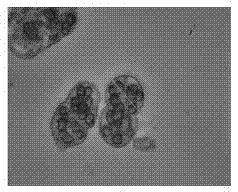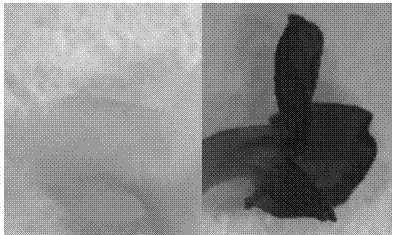Efficient genetic transformation method of hybridized tulip tree
A genetic transformation method and technology of hybrid Liriodendron, applied in the directions of biochemical equipment and methods, botanical equipment and methods, angiosperms/flowering plants, etc., can solve the problems of long growth cycle of hybrid Liriodendron, difficulty in breeding, etc., To achieve the effect of reducing the generation of chimeras and good practicability
- Summary
- Abstract
- Description
- Claims
- Application Information
AI Technical Summary
Problems solved by technology
Method used
Image
Examples
Embodiment 1
[0037] Example 1 Establishment of the Transformation Receptor of Hybrid Liriodendron.
[0038] Successful gene transformation firstly depends on the establishment of a good plant receptor system. The so-called plant gene transformation receptor system means that the explants used for transformation can efficiently and stably regenerate clones through tissue culture or other non-tissue culture methods, and can accept foreign DNA integration, and are sensitive to transformation selection antibiotics regeneration system. Since the 1970s, a lot of work has been done on the plant gene transformation receptor system, and a variety of effective receptor systems have been established successively, which are suitable for the requirements of different transformation methods and different transformation purposes.
[0039] In this example, the hybrid Liriodendron suspension cell line was used as the recipient material. The establishment of suspension cell lines is related to some physic...
Embodiment 2
[0043] Example 2 Preparation of Agrobacterium.
[0044] The culture, growth state and purity of Agrobacterium play an important role in the transformation. If Agrobacterium itself grows poorly, its ability to infect is greatly reduced. If the gene of interest in Agrobacterium has been lost, it cannot be used for transformation. Therefore, the key to transformation is to prepare an Agrobacterium infection solution with high purity, vigorous growth and strong infectivity. This infecting bacteria solution is also called engineering bacteria solution.
[0045] The culture of Agrobacterium can be divided into solid plate culture and liquid shaking culture. Solid culture generally takes 2 to 3 days, and liquid culture grows faster and generally takes 1 to 2 days. Agrobacterium does not start to proliferate immediately after inoculation in liquid medium. It usually takes 1 to 2 hours to start splitting. When growth begins, the number of bacteria doubles at a constant exponential...
Embodiment 3
[0052] Example 3 Infestation.
[0053] The so-called infection is to inoculate the surface of the receptor material with engineering bacteria. The method is to add the prepared Agrobacterium bacteria solution into the culture medium of the receptor material, soak for a certain period of time, and carry out co-cultivation. During the infection process, mastering the infection time will help reduce the possible pollution during the later cultivation process and reduce the poisonous effect of bacteria on plants. The dipping time is too short to allow enough Agrobacterium to attach to the explant wound, thereby reducing the frequency of genetic transformation. If the dipping time is too long, it is easy to cause allergic reaction of the explants, and at the same time, it may cause Agrobacterium contamination in the subsequent culture process, which will eventually lead to browning and death of the explants. The specific operation is as follows:
[0054] Shake the bacterial solut...
PUM
 Login to View More
Login to View More Abstract
Description
Claims
Application Information
 Login to View More
Login to View More - R&D
- Intellectual Property
- Life Sciences
- Materials
- Tech Scout
- Unparalleled Data Quality
- Higher Quality Content
- 60% Fewer Hallucinations
Browse by: Latest US Patents, China's latest patents, Technical Efficacy Thesaurus, Application Domain, Technology Topic, Popular Technical Reports.
© 2025 PatSnap. All rights reserved.Legal|Privacy policy|Modern Slavery Act Transparency Statement|Sitemap|About US| Contact US: help@patsnap.com



